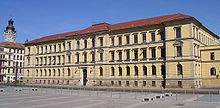Constitutional Court of the Free State of Saxony

The Constitutional Court of the Free State of Saxony is the constitutional court of the Free State of Saxony . The court is a supreme organ of state next parliament and government ( see: Constitution of the Free State of Saxony ). The constitutional court has its seat in Leipzig , in the district court building in the Harkortstrasse.
Composition and choice
The Constitutional Court consists of nine judges. A deputy is assigned to each of these judges. Five of the constitutional judges, including the President and Vice-President, must be professional judges. The judges are elected by the Saxon state parliament, at the suggestion of the state government or the state parliament presidium, with a majority of two thirds of its members for a period of nine years.
Furthermore, the incompatibility of the office of constitutional judge with membership of an organ of the legislative branch, the executive branch at state, federal or EU level as well as the Federal Constitutional Court or the European Court of Justice applies .
administration
Administration is carried out by the President.
tasks
The Constitutional Court decides on the following aspects, which are regulated in Art. 81 Para. 1 SächsVerf and which essentially correspond to the procedures of the Federal Constitutional Court:
- the interpretation of the Saxon constitution in organ dispute proceedings ,
- the compatibility of state law with the constitution of the Free State of Saxony in the procedure of abstract control of norms (application possible by a quarter of the legal members of the state parliament or the state government),
- the compatibility of a state law with the Saxon constitution in the context of specific norm control ,
- the violation of fundamental rights of the Saxon constitution in constitutional complaints
as well as on other matters that are assigned to it in the constitution (e.g. preventive abstract control of norms in the case of referendums in accordance with Art. 72 para. 2 SächsVerf) or by law.
history
Despite its short existence since 1993, the Constitutional Court of the Free State of Saxony can look back on a long tradition. A “State Court” of the Kingdom of Saxony was set up as early as 1831, a forerunner of today's Constitutional Court, which was abolished in 1918 with the proclamation of the Free State of Saxony. Until the federal states were brought into line in 1933, the State Court of Justice for the German Empire with its seat in Leipzig was responsible for constitutional disputes within the Free State of Saxony (Art. 19 Constitution of the German Empire of August 11, 1919). In these cases, among other things, the President of the Saxon Higher Administrative Court was a member of the State Court (Section 18 No. 1, Section 31 of the Law on the State Court of 9 July 1921).
In the years after 1945 a constitutional court was not re-established, judges did not have to examine the constitutionality of the laws, in case of doubt the state parliament decided.
It was not until the constitution of the Free State of Saxony of May 26, 1992 that a constitutional court could be established ( Art. 77, Paragraph 1). With the law on the Constitutional Court of the Free State of Saxony ( SächsVerfGHG ) of February 18, 1993, the Saxon Landtag determined the seat of the Constitutional Court in Leipzig. On July 15, 1993, the first members of the court and their deputies were sworn in in the Saxon state parliament and met on the same day for their first consultation.
| Surname | Term of office | |
|---|---|---|
| 1 | Günter Hirsch | 1993-1995 |
| 2 | Thomas Pfeiffer | 1995-2005 |
| 3 | Klaus Budewig | 2005-2007 |
| 4th | Birgit Munz | since March 14, 2007 |
The current Vice President of the Constitutional Court is Uwe Berlit (presiding judge at the Federal Administrative Court ).
See also
- Constitution of the Free State of Saxony
- List of the courts of the Free State of Saxony
- List of German courts
- Category: Judges (Constitutional Court of the Free State of Saxony)
Web links
- Official website of the Saxon Constitutional Court
- Rules of Procedure of the Constitutional Court of the Free State of Saxony
- Overview of the case law of the Saxon Constitutional Court
Coordinates: 51 ° 20 '0.7 " N , 12 ° 22' 17.2" E
